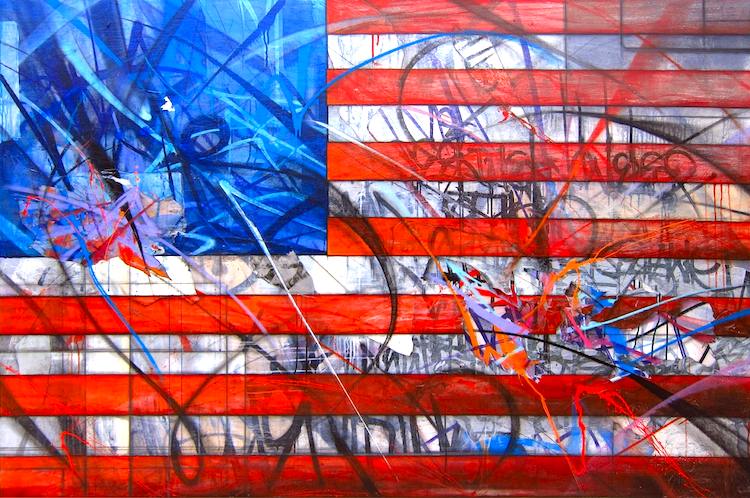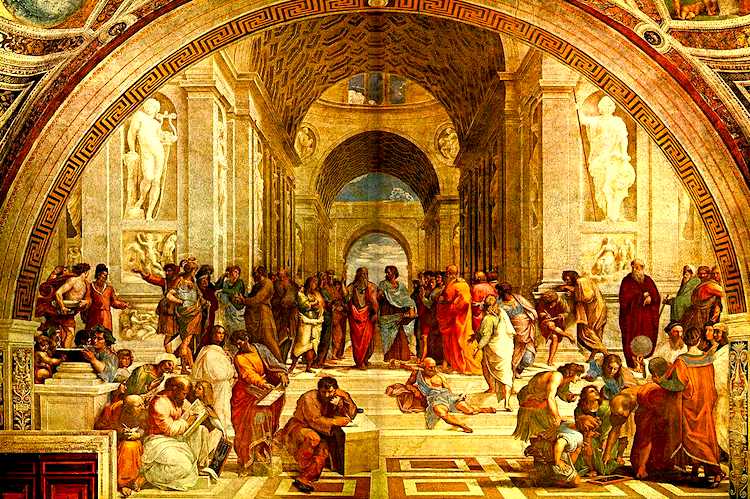
By David Ross. L.A.’s Museum of Contemporary Art has opened an exhibition of graffiti art, in response to which Heather Mac Donald (see here) has written what is perhaps the single most effective and thorough demolition of radical chic that I have ever encountered. Here’s her lead, all of which she elaborates to devastating effect:
MOCA’s exhibit, Art in the Streets is the inaugural show of its new director, Jeffrey Deitch, a former New York gallery owner and art agent. Deitch’s now-shuttered Soho gallery showcased vandal-anarchist wannabes whose performance pieces and installations purported to strike a blow against establishment values and capitalism, even as Deitch himself made millions serving art collectors whose fortunes rested on capitalism and its underpinning in bourgeois values. MOCA’s show (which will also survey skateboard culture) raises such inconsistencies to a new level of shamelessness. Not only would MOCA never tolerate uninvited graffiti on its walls (indeed, it doesn’t even permit visitors to use a pen for note-taking within its walls, an affectation unknown in most of the world’s greatest museums); none of its trustees would allow their Westside mansions or offices to be adorned with graffiti, either.
Even this two-facedness pales beside the hypocrisy of the graffiti vandals themselves, who wage war on property rights until presented with the opportunity to sell their work or license it to a corporation. At that point, they grab all the profits they can stuff into their bank accounts. Lost in this antibourgeois posturing is the likely result of the museum’s graffiti glorification: a renewed commitment to graffiti by Los Angeles’s ghetto youth, who will learn that the city’s power class views graffiti not as a crime but as art worthy of curation. The victims will be the law-abiding residents of the city’s most graffiti-afflicted neighborhoods and, for those who care, the vandals themselves.
I intended to add certain withering comments of my own, but Mac Donald leaves nothing unsaid. She delivers a pounding. She pounds into fragments and then into dust and then she sweeps the little pile of refuse into the sewer and bids it arrivederci. If you want to know how to conduct a culture war, look no farther.
I cannot resist drawing attention to this a little episode from la vie belle of Mr. Deitch:
For one of his New York dinner parties, he commissioned a performance piece in which unclothed gay Austrians urinated into one another’s hats while standing on a scaffold above the dinner guests.
I would not care to eat dinner under a cross-fire of micturation, but what do I know? A drop or two of uric acid may do wonders for a hollandaise sauce.
Mac Donald refers to the “graffiti glorification industry” and indeed it is an industry. Netflix does not cater to anyone with an interest in Giovanni Bellini or Raphael, but graffiti commentary – like graffiti itself – is all over the place. Doug Pray’s Infamy (2005) is probably the primary document. Oscillating between neutrality and sneaking admiration, it becomes in spite of itself a devastating portrait of moral breakdown and social deviancy, a real-life Clockwork Orange. Other stream-able offerings include Tony Silver’s Style Wars (1983); Street Prophetz (2003); Banksy’s riddling Exit Through the Gift Shop (see me comments here); Pablo Arevena’s Next: A Primer on Urban Painting (2005); Danny Lee’s Rock Fresh (2006); John Reiss’ Bomb It (2007); Bob Bryan’s Graffiti Verite (see here), which at eleven volumes is more sprawling than Ken Burns’ Civil War; and Aaron Rose and Joshua Leonard’s Beautiful Losers (2008). There’s even a how-to video: Bryan’s Graffiti Verite 4: Basic Techniques for Creating Graffiti Art on Walls & Canvas (2003). All of these films are effectively incitement to crime, but what’s a little urban decay to those who don’t have to deal with it?
I watched or skimmed all of these films in a version of the stations of the cross. By the end, I was squirming with boredom and revulsion. The documentaries are bombastic and stylish (if morally confused) in keeping with their subject matter, and not badly done. The problem is the subject matter itself, the endless and tedious repetition of the same kind of image and the same kind of narrative, each ‘artist’ introduced as a pretext for a predictable vignette about victimization and transgression, or offering his or her own diatribe along the same lines. What’s most remarkable about these documentaries is their complete fungibility.

There seem to be three general categories of graffiti artist: thuggish social deviant (the vast majority), postmodern provocateur (Banksy, Shepard Fairey, Mr. Brainwash), and stunted artist proper (Saber). The nimble and ironic Banksy aside, graffitists, whatever their persuasion, repetitively adhere to the same clichéd and crude narratives of their lives and their art – alienation manifesting as defiant politics and subversive expression – and exhibit no apprehension that the artist must ceaselessly war against cliché, even against the clichés of his own concrete reality and lived experience. Lacking philosophy, not to mention basic education and basic curiosity, the graffitists are mostly slaves to the adolescent self-absorption that manifests itself in the ‘tag’ – the endless, meaningless repetition of the artist’s own name. A good number of these artists have visual flair and a few have real talent, but they are dopey provincials of the youth culture all the same.
Attempting to justify the urban scourge of tagging, Bomb It sententiously opens with a quote from Goethe’s “Poetry and Truth” (1811):
I was, after the fashion of humanity, in love with my own name, and, as young educated people commonly do, I wrote it everywhere.
Goethe was presumably not defacing other people’s property, and whatever he was up to was not all he was up to. Would we remember Goethe two hundred years later if he had truly adopted the life of the graffitist and dedicated himself to scrawling “G-Man” on the facades of cathedrals and chateaux? The bravos of some justifiably annoyed aristocrat would have tied him up and thrown him into a lake, thus ending the G-Man’s brief and meaningless life.
Saber, a 35-year-old white Angelino, is the best of the crop (v. Infamy). A graffitist turned what we might call visual entrepreneur, he clearly wants to transcend the limitations of graffiti and the confines of graffiti culture, and he seems to want to trade on the merits of his art rather than merely commercialize a canned ghetto mystique. He has made undeniably striking images. The question is whether he can make art. I think he can and I hope he does, if only to expiate in some tenuous way what are, after all, his crimes.
See also my comments of Jean-Michel Basquiat here.
Posted on May 25th, 2011 at 12:45pm.
Heather Mac Donald (two words, not McDonald) is a superb writer and critic. She often writes for City Journal at http://www.city-journal.org/, and they have a great set of writers there: Stephen Malanga, James Panero, Theodore Dalrymple, and the redoubtable Ms. Mac Donald.
Thanks, Paul. I’ll make the correction on her name.
Graffiti as a medium for expression requires several elements. Paint, a canvas of some smooth surface, guts, a creative sense and most importantly, a civic government so unconcerned with the urban environment that they refuse to dedicate resources to erase it within a day or two. When the masterwork you risked arrest and incarceration for is gone the next day, your incentive to continue such an “artistic” career is severely dampened.
Despite Ms. Mac Donald’s proclamation that the MOCA show ” …celebrates vandalism”, I found it to be a worthwhile experience. An opportunity to view the work of many artists who I was not previously familiar with. To dismiss the show as ‘graffiti art’ is disingenuous, to say the least. Ms. Mac Donald paints her review with a very broad brush and as such misses the mark. Different strokes…
As an artist myself and a conservative, I understand the difficulty many of us on the right face when the subject of art comes up. Articles, such as the one written by Heather Mac Donald, don’t seem to help. Oh well.
I will continue to keep an open mind, to seek out work which inspires me. Which excites me. Has me thinking. Reflecting. Work which I can enjoy.
One of the side benefits of attending the MOCA show was a discussion I had with my oldest son (29) and him introducing me to a talented young artist named Vhils. I would invite any interested person to check out this link to his work:
http://www.thestreetartblog.net/search/label/Vhils
In particular, his ‘Scratching the Surface’ video (scroll halfway down). Yes, he’s a ‘street artist’ and in my opinion he’s creating some of the most beautiful, awe inspiring work I’ve encountered in quite sometime.
Had it not been for ‘Art in the Streets’ @ MOCA, the fine work of Vhils may have escaped me.
Instead…I am jazzed.
Take care.